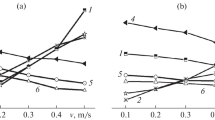New boride cermet coatings have been developed. These cermets consist of Mo-system ternary boride and iron-gr. metal. MoCoB-Co/Cr cermets have a very low friction coefficient with glass at high temperature. The cermet coating has been applied in a glass forming process, and the productive efficiency of the process is improved substantially.
Similar content being viewed by others
Avoid common mistakes on your manuscript.
A newly developed cermet coating has been applied to a process for hot-forming of glass sheets. The production yield variance of the forming process improved appreciably by using this cermet coating. Especially, the average defective fraction due to cracking of the glass decreased markedly.
In this process, a glass sheet, cut in the prescribed form, is placed in a lower mold made of stainless steel (Fig. 1) and the glass is pressed carefully by the upper mold that is coated with a glass fiber textile. The edge of the glass sheet has to slide smoothly on the surface of the lower mold during the pressing. If the glass edge sticks on the mold during this operation, cracks are generated. Sticking is caused by mechanical and thermal stresses due to friction or chemical adhesion between the glass and mold material. Some types of mold-releasing agents are being applied often on the surface of lower mold, but their effect decreases after a short period. As a result, consecutive forming has not been possible for complex-forming operations at high processing rate and the production efficiency has been extremely low.
Some surface modification of the lower mold has been tested out, unsuccessfully. For example, thermal sprayed coatings of WC-Co and Cr3C2-Ni/Cr were applied on molds to improve wear resistance and friction performance, but the results were not satisfactory. After a few dozen operations of glass forming, the coatings were abraded due to oxidation at the operating temperature 873-923 K. Wastage of the latter was exacerbated beyond expectation, despite their superiority in oxidation resistance, because glass, compressed against the mold at such high temperatures, accelerated the oxidation of the sprayed coating. Additionally, some cracks were observed in the coating layer, because the lower mold is somewhat resilient and deforms slightly at every glass forming.
Thermal spray coatings of boride cermets were developed for this application. These cermets consist of Mo-based ternary boride and iron group metal alloys, and have the following outstanding characteristics at 773-1073 K:
-
Extremely low friction coefficient to glass
-
Oxidation resistance higher than other cermets (WC-Co, Cr3C2-Ni/Cr, etc.)
-
Very low mechanical abrasion.
These superior characteristics suggested that these cermets could be effective for the coating of the lower mold in the glass-forming process at high temperatures.
The friction coefficients between the cermet coating and SiO2-CaO type glass, and also Al2O3 were measured. Figure 2 shows the measurement method. The test piece and the glass sheet were heated to 873 K in air, and the former was moved over the latter at a constant speed (50 mm/min). During the sliding, the frictional load between the test piece and glass was estimated with a load cell. The friction coefficients between two types of boride cermet coatings (Mo2NiB2-Ni, MoCoB-Co/Cr) and SiO2-CaO type glass or Al2O3 are compared with those for stainless steels, polished or covered with BN mold lubricant (Fig. 3). High friction stress was noted between 18Cr-Ni stainless steel and glass. It is shown that friction stress with the glass can be reduced by boride cermet coatings, but not by BN-lubricant. On the other hand, the difference in friction coefficients of the four samples was not so high for Al2O3 ceramics. The MoCoB-Co/Cr coating and BN-lubricant were slightly effective in reducing the friction stress with Al2O3 ceramics.
It is believed that the mechanisms resulting in friction stress of the two coatings are not same. To better understand the difference, test pieces were investigated carefully after the measurements. In the case of Mo2NiB2-Ni cermet, the surface of the thermal sprayed layer contained powder, and the glass had a hazy appearance. It is thought that the powder was generated by oxidation of the cermet and thus acted as a lubricant; however, the hazing of the glass is not acceptable. On the other hand, a dark-colored thin film appeared on the surface of the MoCoB-Co/Cr cermet and the glass was clear after the test. The cross section of the cermet layer was analyzed by SEM-EDS (Fig. 4). The thin film included two layers of Mo-Co-Cr oxides, each of a different composition ratio. The top layer had a higher Mo content than the second layer. It is possible that the effect of the boride cermet coating in reducing friction stress are caused by the Mo oxide.
Since the tests mentioned above, the coating of MoCoB-Co/Cr cermet has been applied to the lower mold on an industrial scale and the results are very satisfactory. In particular, the production efficiency of the forming process has improved substantially.
Author information
Authors and Affiliations
Corresponding author
Rights and permissions
About this article
Cite this article
Hamashima, K. Application of New Boride Cermet Coating to Forming of Glass Sheets. J Therm Spray Tech 16, 32–33 (2007). https://doi.org/10.1007/s11666-006-9008-1
Received:
Revised:
Published:
Issue Date:
DOI: https://doi.org/10.1007/s11666-006-9008-1








